Are you familiar with Shinjuku Ward in Tokyo? As one of Tokyo’s 23 wards, it showcases diverse neighborhoods and districts, offering lots of activities and attractions. For a comprehensive understanding of Shinjuku Ward, including its distinct areas, top attractions, historical background, accommodation choices, and more, explore this comprehensive guide.
A Primer to Shinjuku Ward

Shinjuku Ward in Tokyo, encompassing the vicinity around Shinjuku Station, has evolved since the conclusion of World War II into what is now recognised as the Yamanote subcenter.
Despite its emergence as a central hub in the city, there are notably numerous dilapidated apartments and public housing complexes where elderly welfare recipients and single foreign households reside, all within convenient walking or cycling distance of this bustling metropolis, where throngs of commuting businessmen navigate crowded trains on various railway lines. The prevalence of foreign residents and welfare recipients in Shinjuku City is undeniable.

During the Edo period, when Shinjuku was initially established as Naito Shinjuku, it has firmly entrenched itself as one of Japan’s most prosperous districts. However, its historical inns from the Edo era, known as iimori inns, akin to contemporary brothels, were also prominent. The present-day Shinjuku Ni-chome area was the epicentre of such establishments.
The iimori inns of the Edo period, akin to brothels, were concentrated in the current Shinjuku Ni-chome area, highlighting the diverse congregation of individuals in this district, which surpasses any other in Tokyo in terms of its vibrant atmosphere.
Living in Shinjuku Ward

Shinjuku Ward is delineated into two sections by the Yamanote Line, one to the west and the other to the east. The Shinjuku area situated within the Yamanote Line, barring special zones like Okubo and Toyama Heights, is characterised by antiquated shopping arcades, with minimal influx of new residents, rendering it a challenging living environment. The landscape is not conducive to habitation, featuring primarily small supermarkets resembling convenience stores or privately owned shops managed by elderly proprietors.
In Tokyo, there exists a faction of “Yamanote line inner city fundamentalists” who take pride in their living locale, upholding the notion that “the only authentic Tokyo lies within the Yamanote Line.”

Elevated residential regions such as Yotsuya and Ushigome boast numerous upscale dwellings. Nonetheless, even within Shinjuku City, areas like Tomikyucho have witnessed extensive redevelopment initiatives, attracting an influx of new inhabitants.
Beyond the Yamanote Line lie districts such as Nishi-Shinjuku, Kita-Shinjuku, Ochiai, and Nakai. However, these residential areas bear resemblance to those in Nakano City. Surprisingly, even in proximity to the towering skyscrapers of Nishi-Shinjuku, decrepit apartments remain commonplace, rendering them affordable for economically disadvantaged individuals. Indeed, a significant number of foreign labourers inhabit the modest apartments near Okubo and Shin-Okubo stations, contributing to a notably multi-ethnic populace.
History of Shinjuku Ward

On March 15, 1947, the former Yotsuya, Ushigome, and Yodobashi wards amalgamated to establish Shinjuku-ku. This designation was chosen not solely for its historical roots but also due to the renown of Shinjuku Gyoen and Shinjuku Station, renowned landmarks throughout Japan.
The contemporary Shinjuku City emerged on March 15, 1947, following the fusion of the former Yotsuya, Ushigome, and Yodobashi wards. Yotsuya and Ushigome wards were established in 1878 as part of the 15 wards of Tokyo Prefecture, while Yodobashi ward remained divided into Yodobashi-cho, Okubo-cho, Totsuka-cho, and Ochiai-cho within Toyotama County.
As urbanisation advanced, the population of these four towns surged by 62% in 1930 compared to 1920, accentuating the administrative disparities between the city and county sectors. This spurred a movement to annex the urban segment, resulting in the amalgamation of the four aforementioned towns in October 1932 to form Yodobashi Ward.
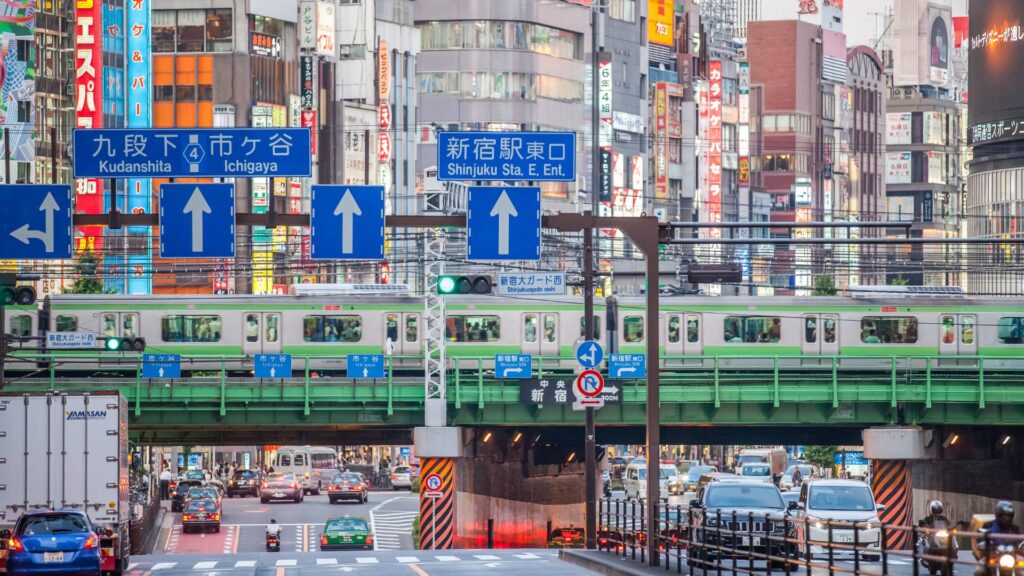
During this period, the vicinity surrounding Shinjuku Station burgeoned with department stores, cinemas, theatres, cafes, and more, evolving into a prominent shopping district, supplanting Yotsuya and Kagurazaka, erstwhile renowned as upscale shopping areas since the Meiji era. The Tokyo Air Raid from May to August 1945 wrought profound changes upon the landscape of the region.
The pre-war grandeur of the Shinjuku Station vicinity, Yotsuya, Kagurazaka, and Takadanobaba was obliterated, reduced to charred ruins by the ravages of fire. Before the conflict, there were 63,295 households across the three former wards, yet due to wartime evacuations and destruction, 56,459 households were lost, leaving a mere 6,836 households. Amidst this upheaval, the district embarked on the path to reconstruction. In March 1947, the three wards of Yotsuya, Ushigome, and Yodobashi unified to establish the new Shinjuku City.
Areas in Shinjuku Ward
Along the Subway Marunouchi Line
Shinjuku 新宿

One of Japan’s largest terminal stations, Shinjuku Station has undergone remarkable changes, including the opening of Basta Shinjuku at the south exit. Kabukicho, once an underworld district, has been transformed into a major tourist attraction. Foreign tourists take commemorative photos everywhere.
Shinjuku 3-chome 新宿三丁目

The towering Isetan department store was and still is a landmark. It is a shopping area in the Yamanote district of Tokyo, akin to Ginza. However, the rooster market at Hanazono Shrine is frequented by yakuza-like men, and Shinjuku Golden Gai, where the postwar blue line became a drinking district, is still thriving.
Shinjuku Gyoenmae 新宿御苑前

This is the closest station to Shinjuku Ni-chome, the world’s LGBT town where gay residents of Nakano Ward gather on the Marunouchi Line. The rapidly developing “24” sauna and rental pool studio are notable attractions. Formerly a brothel and red-light district, this area originated in Naito Shinjuku.
Yotsuya 3-chome 四谷三丁目

The supermarket Marumasa Foods, the pride of Shinjuku City, and the Oiwa Inari Shrine, associated with the Yotsuya Ghost Story, are notable landmarks. Arakicho, a drinking district at the bottom of a valley with a mortar-shaped topography, is an adult’s hideout and was a red-light district in the past. The building where Showa-era idol Okada Yukiko tragically committed suicide still stands at the corner of the Yotsuya 4-chome intersection.
Yotsuya 四ツ谷

The area around the station is an elite town with Gakushuin Elementary School, Sophia University, and the Bancho district of Chiyoda Ward, the most expensive residential area in Japan. On the other hand, if you go down Entsuji Slope, you will find the valley-bottom towns of Wakaba and Minami-Motomachi in the old Samegawabashi slum, where public bathhouses and wooden apartments are still crowded.
Nishi-Shinjuku 西新宿
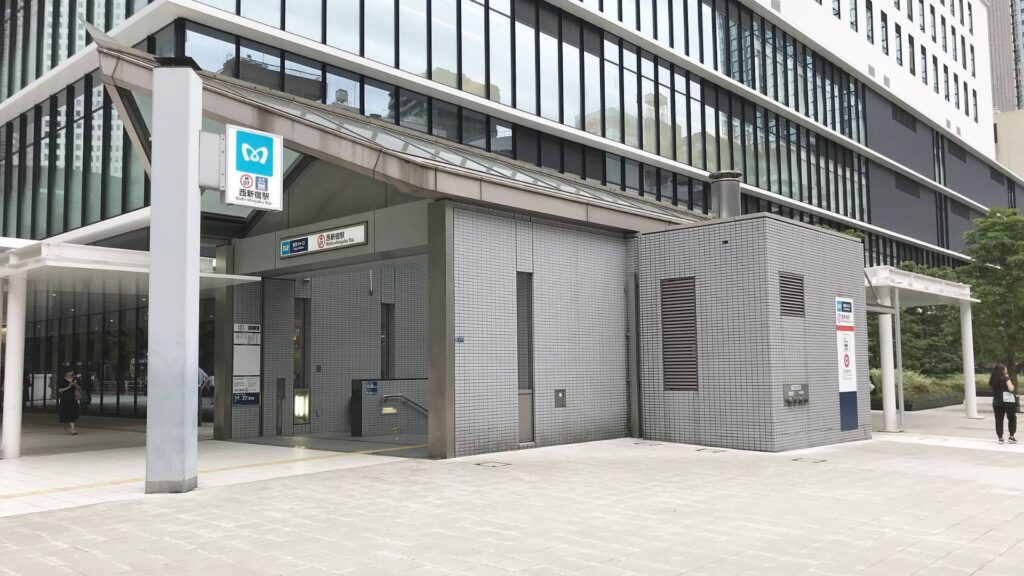
The north side of the Nishi-Shinjuku skyscrapers includes the area formerly known as Kashiwagi-cho. Entering Nishi-Shinjuku 8-chome, you will be surprised to see a cluster of wooden apartment buildings that still remain. The area near Nariko Tenjinsha Shrine, famous for its Fuji-zuka, has also been transformed into a high-rise building area by redevelopment.
Along the JR Chuo and Sobu lines
Sendagaya 千駄ヶ谷

While the area in front of the station falls under Shibuya Ward, the Kasumigaoka Apartments on the south side of the National Stadium are in Shinjuku Ward. Pro-citizens campaigned against the demolition of the apartment complex, which was the planned site for the new National Stadium for the 2020 Tokyo Olympics. Now, with the Olympics over, this area remains a blend of historical and modern developments.
Shinanomachi 信濃町

This religious town is home to the headquarters of the Soka Gakkai, Japan’s largest emerging religious organisation. The recently completed “Kosen-Rufu Grand Vows Hall” is impressive. Recently, the town has been featured in special programmes, such as the Ikegami election coverage by Teletext, indicating a more open atmosphere than in the past. The headquarters of the New Komeito Party is located in Minami-Motomachi at the bottom of the valley.
Ichigaya 市ヶ谷

A town of contrasts, with the Ministry of Defence, a key to Japan’s national security, and Yasukuni Shrine on the opposite side. Nearby, Hosei University, known for its active student body, and the headquarters of the General Federation of Korean Industries are located. The modest fishing pond in front of the station is a well-known landmark. Sunadoharacho is an exceptionally upscale residential area.
Iidabashi 飯田橋

A terminal station in the heart of the city where four subway lines intersect with the JR Sobu Line. The Kagurazaka-dori shopping street offers a charming space for adults, though it can be somewhat gaudy at the bottom of the hill. The pink movie theatre “Kurara Theatre,” located in the back alley of Kagurakoji and Michikusa Yokocho, closed in 2016, leaving behind a nostalgic memory for locals.
Okubo 大久保

Okubo Street near Okubo Station on the Sobu Line is now more Chinese than Korean in character. The Tokyo Mazu Temple, built a few years ago, stands magnificently. The area features the chaotic Hyakuninmachi Ward Apartments along the railroad tracks. Hyakuninmachi 3-chome remains a mystery with its haphazard plots.
Along the JR Yamanote Line and Seibu Shinjuku Line
Shin-Okubo 新大久保

The area centred on Okubo Street and Shokunan Street is renowned as Japan’s largest Korea Town, but in reality, it is a highly multicultural area. Recently, the number of Chinese, Nepalese, and Muslim residents has been increasing. Muslim Yokocho is a place where you don’t need a passport to feel as though you are in a different country.
Takadanobaba 高田馬場

A popular hangout for students of Waseda University, Takadanobaba is filled with yellow signs advertising student loans. The station serves as the de facto terminal for Seibu Shinjuku Line users. The area boasts many Myanmar restaurants interspersed with the gut-busting eateries catering to students, earning it the nickname “Little Yangon of Japan.” The pitch-black building in front of the station has also been converted into Myanmar-style businesses. There is also a Peace Boat office located here.
Shimo-Ochiai 下落合

A modest area close to Takadanobaba, the vicinity in front of the station is not particularly prosperous. However, on higher ground lies Mejiro-Konoe-cho, a truly upscale residential area. The zero-zero apartments along the railroad tracks are notably narrow and dark.
Nakai 中井

Once famous as a dyeing district and associated with the artist Fujio Akatsuka, Nakai is now a somewhat run-down riverside town. It had a Myanmar community in the 1990s, which later relocated to Takadanobaba. Conveniently situated with access to both the Seibu Shinjuku Line and the Oedo Line, Nakai offers good connectivity despite its current state.
Along the Subway and Toei Line
Waseda 早稲田
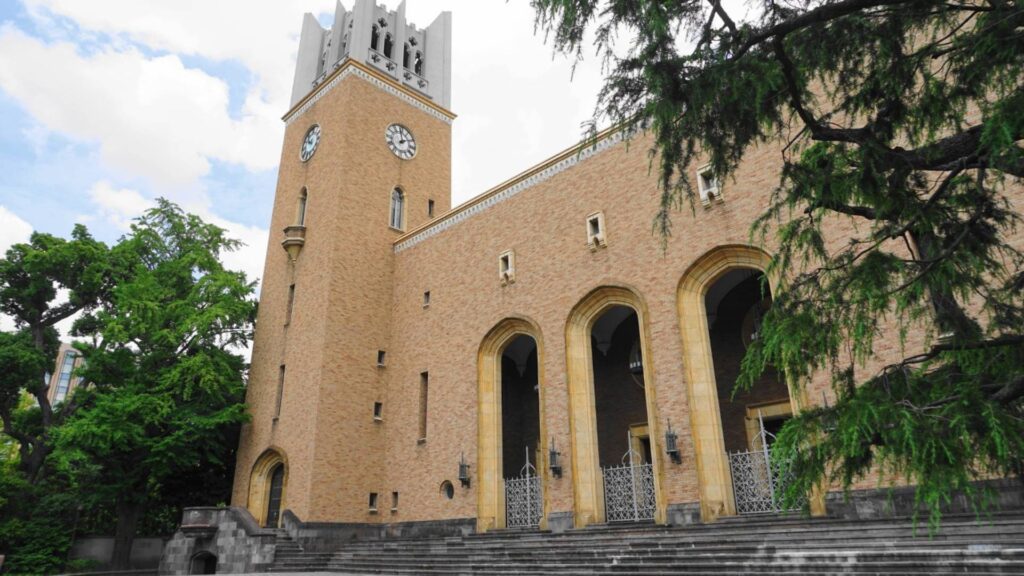
Waseda University’s famous gate town. The flamboyant Bonsyuko designer apartment building in front of the campus. Gutsy cafeterias and many bento box stores for students. The Waseda Service Center, where the Oriental Schindler Chiune Sugihara and Kiyomi Tsujimoto of the Peace Boat were born. The Japan Christ Church Building has become a den of anti-Japanese groups.
Kagurazaka 神楽坂
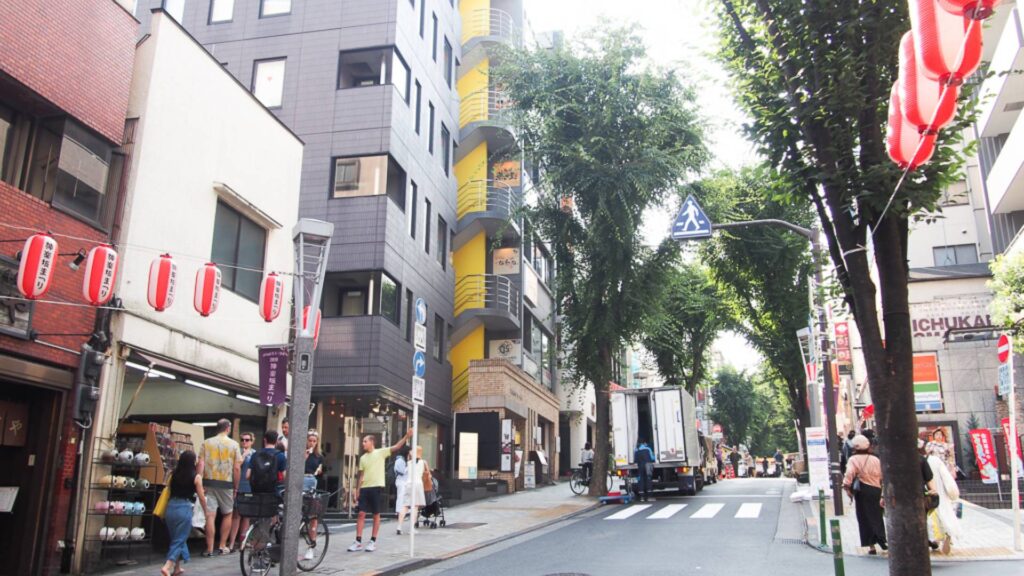
Kagurazaka Street and Hanamachi has, for some reason, become a hangout for French people. The one-way reversible street, which has become an urban legend that Kakuei Tanaka decided to make it a one-way street.
Akebonobashi 曙橋

The old home of Fuji Television, which built its bubbly office building in Odaiba. Fuji Television Avenue was renamed Akebonobashi Avenue. The site is a high-rise condominium adjacent to a Korean school. The property is popular among Korean elite households. The former site of Nagai Kafu’s Danjotei has been turned into a facility for the Dalek, to which Masashi Tashiro belongs.
Higashi-Shinjuku 東新宿
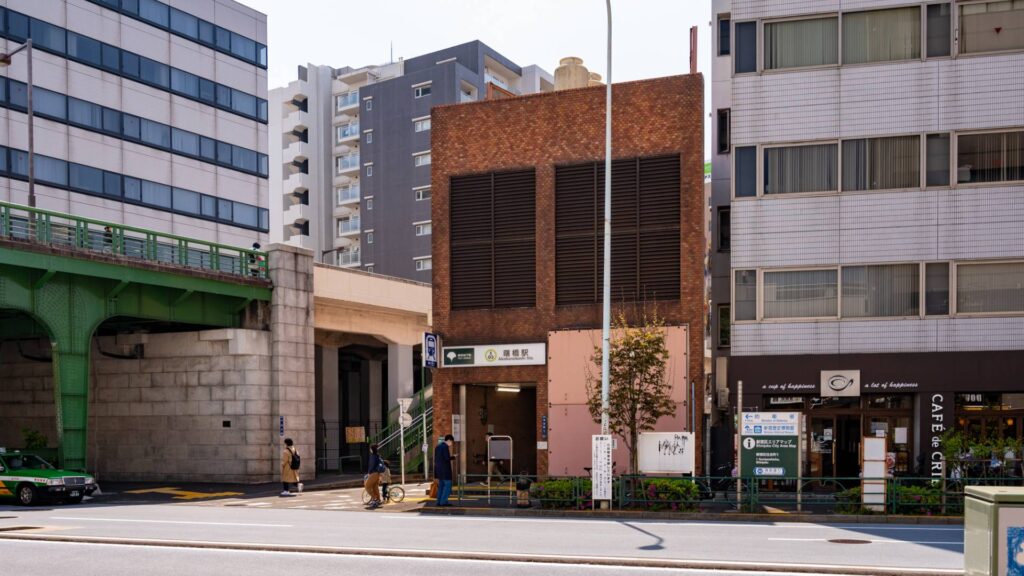
The station is too far away to be named Shinjuku. The original name of the area was Higashi-Okubo. This is the nearest to Shinjuku 6 and 7-chome, where the Kabukicho love hotel district, yakuza apartments, warship apartments, SQUANI headquarters, and old residential areas that do not look very Shinjuku are located.
Wakamatsu Kawada 若松河田
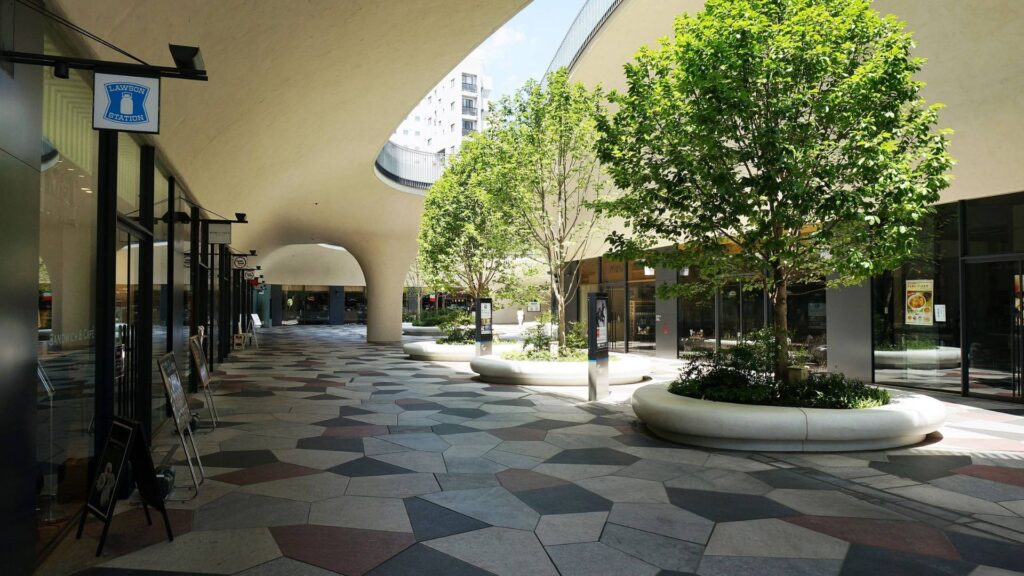
A composite station name of the Oedo Line, Wakamatsu-cho and Kawada-cho. In front of the station is the Count Ogasawara’s residence, and beyond the Women’s Medical College is the Tokyo Korean School. The tower condominiums built on the site of Fuji Television’s old home and the surrounding area are also full of Korean-language billboards. Another Korean town hidden in the shadow of Shin-Okubo.
Along Other Stations
Ochiai

Ochiai is a rather lonely station, boasting the lowest number of passengers, even fewer than Barakinakayama along the Tozai Line. Despite its quiet appearance, it is close to Higashi-Nakano and Nakai. Depending on one’s perspective, it is a town that boasts the convenience of having access to four train lines: the Tozai Line, JR Chuo-Sobu Line, Oedo Line, and Seibu Shinjuku Line. This makes it feel like a hidden gem in the middle of nowhere.
Nishi-Shinjuku 5-Chome 西新宿五丁目

At the western edge of Shinjuku City, Nishi-Shinjuku 5-Chome hosts a bathhouse where the borders of Shibuya and Nakano wards meet, known to have developed into a nightly social gathering place for some. The area retains the remnants of the Twelve Company’s take-in ryokan, lending it a somewhat suspicious atmosphere. This area also features high-rise apartments and is within walking distance of the Shinjuku Central Park.
Tochomae 都庁前

Tochomae is home to the Tokyo Metropolitan Government Building, one of the most iconic structures in Shinjuku, and Shinjuku Chuo Park. During the day, the area is bustling with government workers and visitors. At night, however, the surrounding area becomes a sleeping place for the homeless. The park also hosts various events throughout the year, including festivals and food fairs.
Ushigome Yanagicho 牛込柳町

A narrow residential area behind Ichigaya Yanagicho, Ushigome Yanagicho is characterised by its numerous temples, including the famous Hounji Temple. This quiet neighbourhood is a stark contrast to the bustling centre of Shinjuku, offering a serene atmosphere amidst the city’s chaos.
Ushigome Kagurazaka 牛込神楽坂

Ushigome Kagurazaka is known for Funabashiya, a popular Japanese sweets store on Ushigome Chuo-dori. The area retains a traditional atmosphere with its cobblestone streets and old-style houses. Kagurazaka is also famous for its dining scene, with numerous restaurants offering a range of cuisines from traditional Japanese to French.
Nishiwaseda 西早稲田
Nishiwaseda is a key area for Waseda University students, and Toyama Park is a popular hangout spot. The park, nestled in a secluded area of Shinjuku City, has become more accessible with the opening of the Fukutoshin Line. It features extensive green spaces, sports facilities, and is a common spot for university events and activities. The area is also home to the Waseda University campus, making it a vibrant student hub.
What to Do in Shinjuku Ward
Shinjuku Gyoen National Garden 新宿御苑
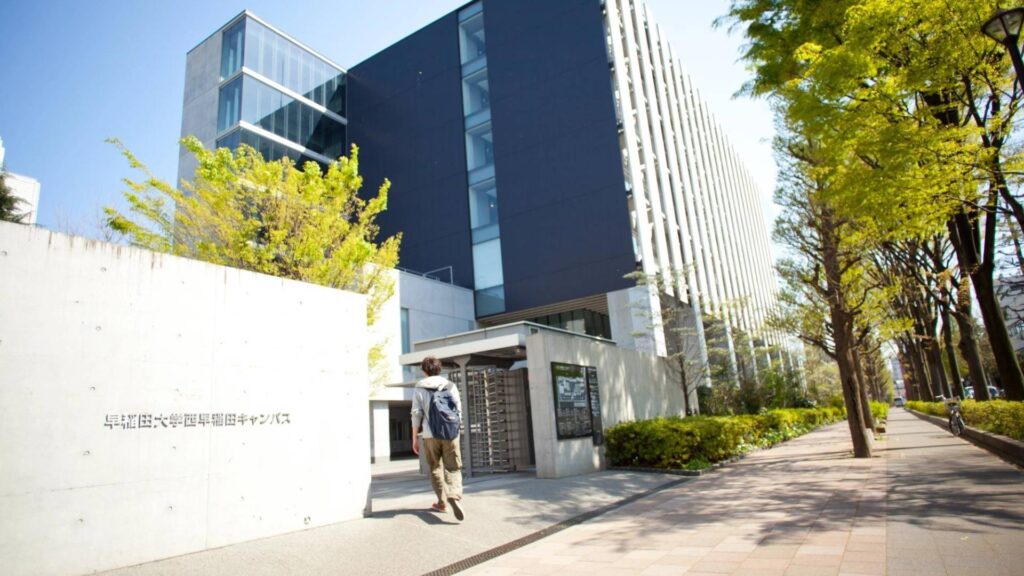
Shinjuku Gyoen is a 58.3-hectare garden with a perimeter of 3.5 km that straddles the Shinjuku and Shibuya wards of Tokyo. Established in 1906 as an imperial garden on the site of the former residence of the Naito family, lords of the Takato domain in Shinshu, it was opened to the public after the war.
The garden is renowned for its modern Western-style design, combining a formal garden, a landscape garden, and a Japanese garden. Its approximately 10,000 trees create a stunning landscape that changes with the seasons. It has been selected as one of the 100 best cherry blossom viewing spots in Japan, with 1,000 cherry trees of about 65 varieties blooming from mid-February to late April.
Find out more about Shinjuku Gyoen National Garden here on Google maps.
Tokyo Metropolitan Government Building 東京都庁

The main building of the Tokyo Metropolitan Government is located in Nishi-Shinjuku, Shinjuku-ku, Tokyo. It consists primarily of the famous twin towers, the First Main Government Building, the Second Main Government Building, the Tokyo Metropolitan Assembly Building, and the Tokyo Metropolitan People’s Square.
The First Main Government Building is a 243-metre-high skyscraper, and the free observation deck on the 45th floor is a popular spot for viewing the entire city of Tokyo. It also houses the Tokyo Tourist Information Centre and the National Tourism PR Corner. The Tokyo Metropolitan Assembly Building, including the 15th (special budget) committee room and the Tokyo Metropolitan Assembly PR Corner, are also open for tours.
Find out more about Tokyo Metropolitan Government Building here on Google maps.
Thermae-Yu テルマー湯 新宿店
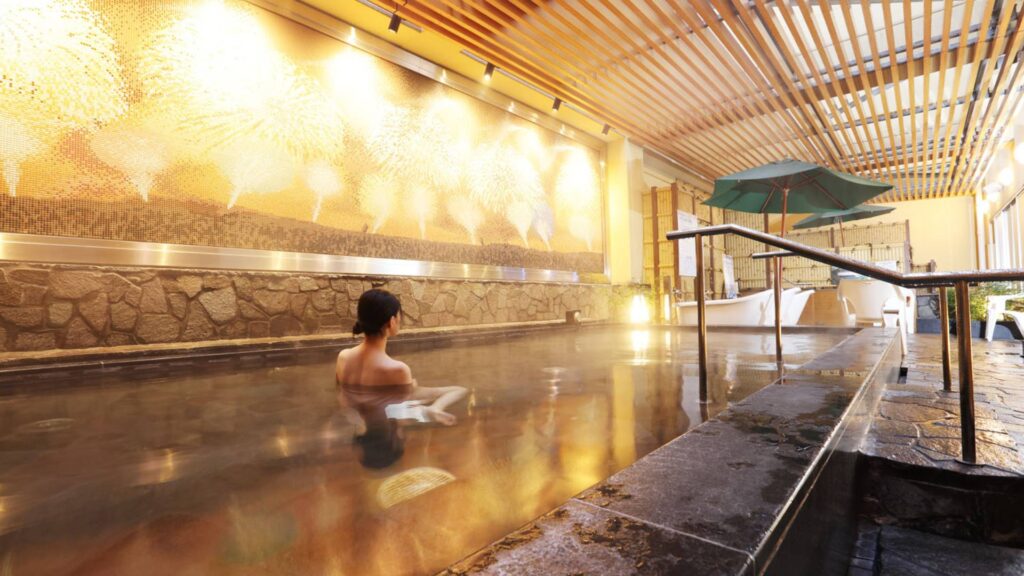
This one-day hot spring facility offers one of the largest highly concentrated carbonated baths in the Kanto region, as well as an open-air bath called “Jindai no Yu” that uses natural hot spring water from Naka Izu. The spacious and luxurious building has a lounge for relaxation and various other facilities, making it popular with female customers and couples on dates.
There is also a Japanese-style pub, an ethnic restaurant, and a juice stand. Open from 11:00 a.m. to 9:00 a.m. the next morning, it is a convenient spot to rest after the last train.
Find out more about Thermae-Yu here on Google maps.
Hanazono Shrine 花園神社

Hanazono Shrine is located in a corner of downtown Shinjuku, Shinjuku-ku, Tokyo, and has been enshrined as the general guardian of Shinjuku since before the Edo shogunate was established. The shrine was called “Hanazono Inari Shrine” because it was built on the site of a beautiful flower garden when it was relocated in the Kan’ei era, from which the current name derives.
Within the precincts of the shrine are the “Intoku Inari Shrine,” which is blessed with prosperity in business, childbearing, and good fortune, and the “Geino Sengen Shrine,” dedicated to the god of performing arts, and visited by many women and entertainers. The Tori-no-ichi (rooster market) held on Tori-no-hi (day of the rooster) every November is the biggest event at the shrine, attracting a large crowd.
Find out more about Hanazono Shrine here on Google maps.
Suehirotei 新宿末廣亭

Suehiro-tei is a regular Yose theatre designated as a cultural asset of Shinjuku City. The performers change every 10 days, with Kamiseki from the 1st to 10th, Nakaseki from the 11th to 20th, and Shimoseki from the 21st to 30th. The venue is spacious, and you are free to eat and drink, except for alcohol. You can enjoy a meal while watching the performance.
Find out more about Suehirotei here on Google maps.
Shinjuku Southern Terrace 新宿サザンテラス

This spot has attracted a lot of attention, stretching long and narrow along the Odakyu and JR lines from the South Exit of Shinjuku Station. Independent buildings such as cafes and sundry stores are scattered along the green-filled promenade. Southern Tower is home to hotels and restaurants.
Find out more about Shinjuku Southern Terrace here on Google maps.
Samurai Museum
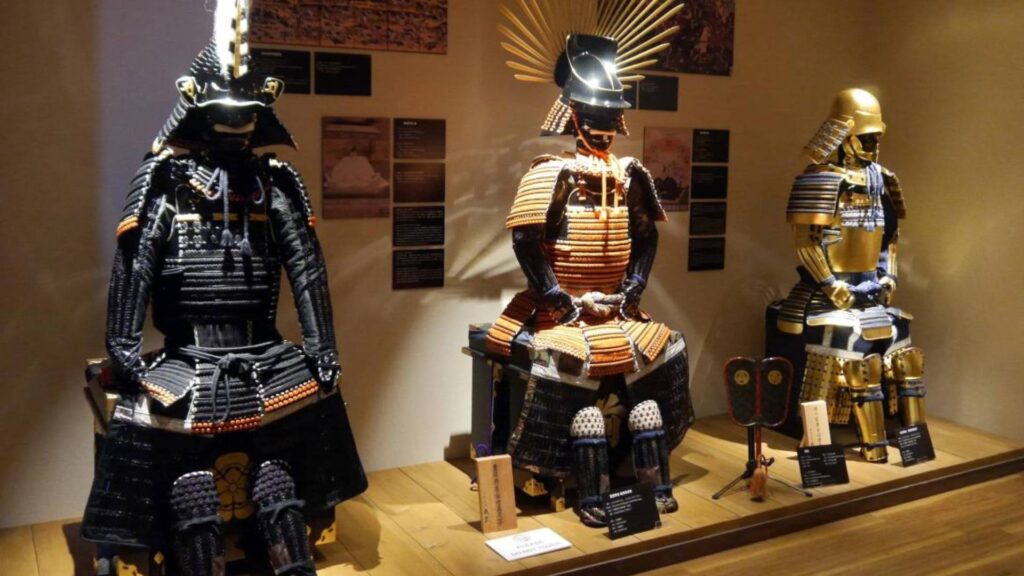
The Samurai Museum in Shinjuku showcases samurai armour, helmets, swords, and other items related to samurai culture. Visitors can have their pictures taken wearing armour and helmets, and watch a sword fight performed in the museum. There are also a variety of souvenirs available for purchase.
Find out more about Samurai Museum here on Google maps.
Golden Gai

In these maze-like alleys of Shinjuku, you can find yourself lost bar-hopping between all the close-quartered bars. Made up of six alleys and even more passageways, these narrow walkways are filled with over 200 different types of bars, izakayas, and restaurants. It is pretty to see during the day but truly comes alive at night. Part of the attraction of Golden Gai is the vibe it has retained from its post-war look, unlike the rest of the eclectic Shinjuku. Packed narrow streets, dimly lit bars, looking a little sketchy, but ever reliable when looking for a good bar.
Golden Gai has become a more popular place for tourists to visit since they want to see what the other side of Tokyo is like, behind all the flashing lights.
Address: 〒160-0021 Tokyo, Shinjuku City, Kabukicho, 1 Chome−1−6 2F Hours: Varies depending on the bar, some open around 5:30 PM, most open around/it gets busy around 9:00 PM
Omoide Yokocho
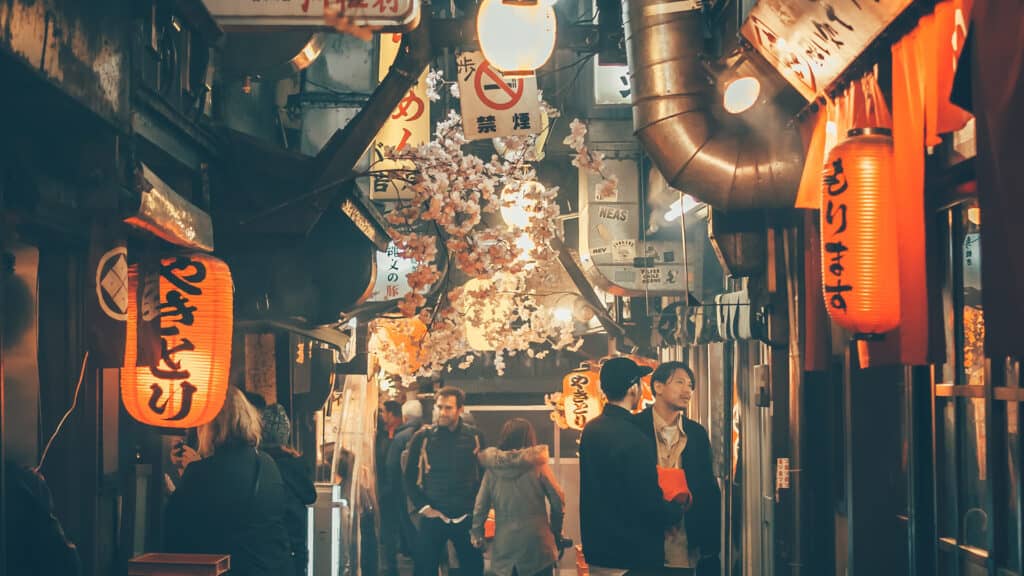
A similar concept to Golden Gai, Omoide Yokocho is an alleyway filled with different restaurants in Shinjuku. Another popular site for tourists, this strip of restaurants offers a different vibe from the rest of Tokyo. This place has Showa-period nostalgia from the post-war period, with the look, feel, and energy of that era. There are about 80 different spots to get food, and the specialty of this alley is the motsuyaki ya and yakitori ya. They also have bars and ticket shops if you don’t want to sit down and eat.
This strip was created after the Second World War when people were in need of money and food, so they set up stalls and other people came to eat cheaper food. It is still around today for people, usually after work, to come and get something cheap and easy to eat.
Address: 1 Chome-2 Nishishinjuku, Shinjuku City, Tokyo 160-0023 Hours: Open 24 hours
Kabukicho

This area of Shinjuku is known as the infamous largest red-light district in Tokyo. It is also an entertainment district. With different sightseeing opportunities during the day transforming into underground life during the night, there is something for everyone to enjoy in Kabukicho. This district includes the Toho building, Golden Gai, Don Quijote, and more for tourists to see during the day. At night, there are plenty of bars, nightclubs, host/hostess clubs, sex shops, love hotels, and more.
Despite how it sounds, Kabukicho is a safe place to visit at night, but make sure to be aware of your surroundings. It is a fun and energetic place that is unlike many other places you would visit and definitely worth seeing.
Shin-Okubo Korean Town

One of the most popular spots for the younger crowd to hang out is Tokyo’s biggest Koreatown, located in Shinjuku. Here, you can find all things about South Korea, whether you’re looking for food, beauty products, pop culture items, or just a fun place to walk around. Authentic Korean food, whether from sit-down restaurants or street food vendors, is best found in Shin-Okubo. You can find both mild and spicy options of virtually any type of food you’re looking for.
K-Beauty products are just as popular in Japan as Japanese products, with places like Skin Garden, Skin Holic, Nature Republic, and more. If you’re also a fan of K-Pop, you can find shops that sell merchandise and albums, and there is a shop called Showbox where up-and-coming K-Pop idols will do pop-up shops and meet-and-greets with fans. The Don Quijote in Shin-Okubo even sells a lot of Korean products at discounted prices.
Overall, Shin-Okubo is a fun area to explore, especially if you are a fan of Korean products or pop culture.
Toho Building
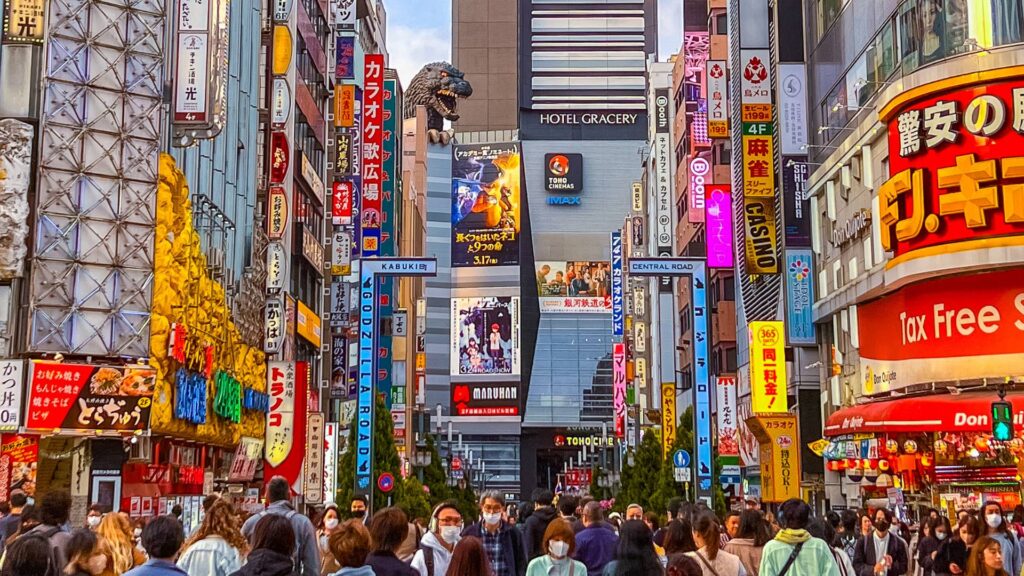
Known for the infamous Godzilla head sticking out over the top of the eighth floor, the Toho building is a pillar of entertainment in Shinjuku. Spanning 30 floors, the first eight are open for anyone to explore, and from the eighth floor up, it turns into a hotel. With shops, restaurants, a Toho Cinema, Pachinko and slot machines, and more, this building looks cool from the outside and is even more fun inside.
Stay in the hotel and have coffee in the morning next to the giant Godzilla, or just stop in to get dinner and see a movie, or try your luck in the pachinko slots. Either way, the Toho building is there to entertain in the perfect area in Shinjuku.
Address: 1-chōme-19-1 Kabukichō, Shinjuku City, Tokyo 160-0021 Hours: Open 24 hours
Lumine the Yoshimoto
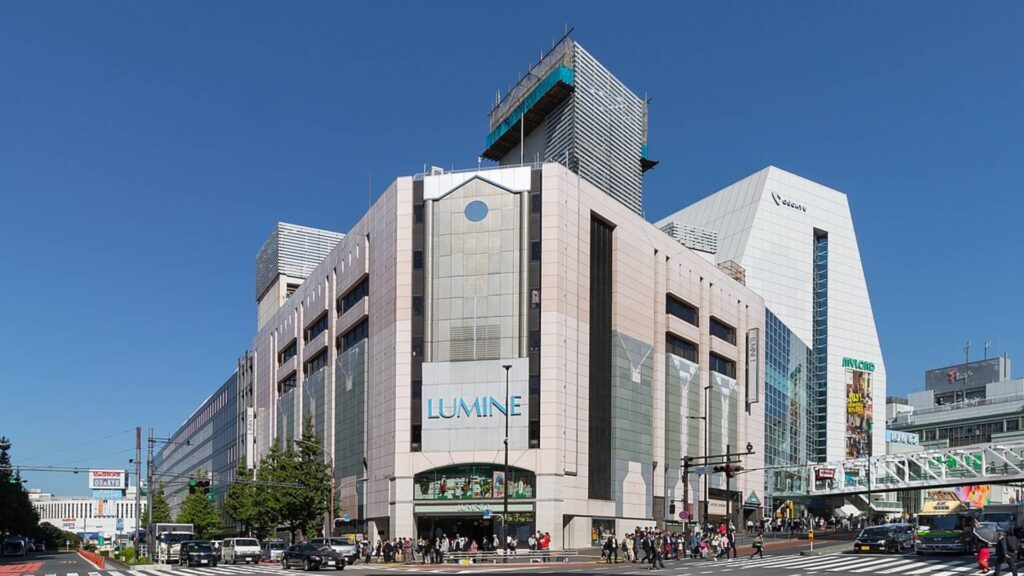
If you’re a fan of comedy, stop by the seventh floor of the Lumine building in Shinjuku, which hosts comedy performances every day in the form of duos, skits, and even high-level comedians. At night, they have more stand-up shows and different kinds of live events planned. This performing arts building is run by a talent agency well-known for producing some of the best comedians.
This Lumine building, known as Lumine 2, also has levels of shopping and restaurants underneath the comedy agency. They sell fashion, beauty, lifestyle goods, and more, so you can do more within the building before or after you see a comedy show.
Address: 〒160-0022 Tokyo, Shinjuku City, Shinjuku, 3 Chome−38−2 ルミネ2 7F Hours: 11:00 AM- 8:00 PM
Tokyo Toy Museum
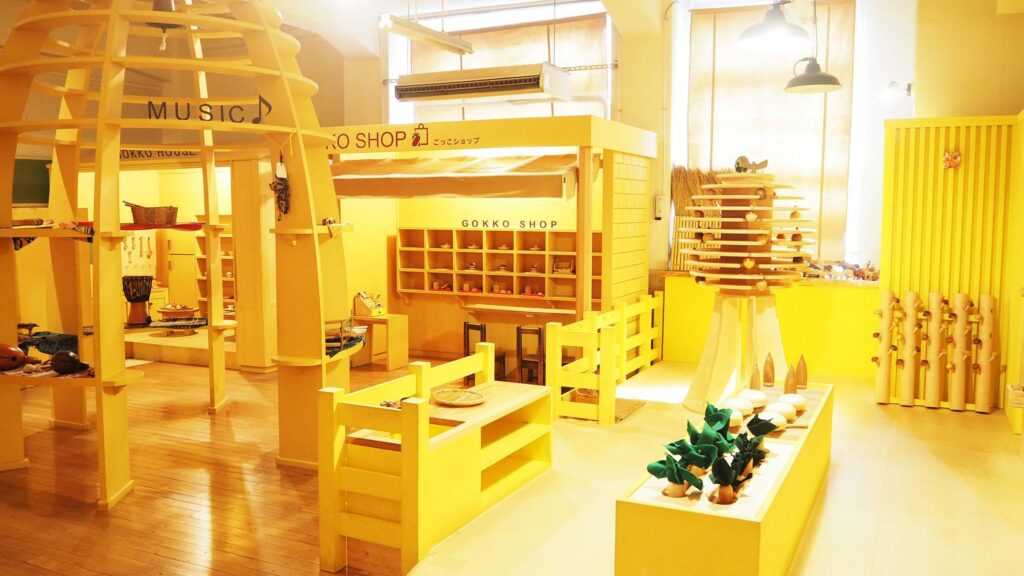
Renovated from an old school building, this toy museum in Shinjuku is home to over 10,000 toys from countries all over the world. The goal of this museum is to engage with people and allow them to just hang out and play with each other. This is a great museum for people of all ages, with even a playroom for babies to stay entertained in. You can learn about Japanese games and play them, as well as games from all over.
There are also craft activities offered throughout the day that allow you to make crafts with recyclable items. Since the museum is in an old school building, each classroom is dedicated to different categories of toys to help guide you on your way through the museum. It is a unique experience that is fun for anyone and perfect for a day in Shinjuku.
Address: 〒160-0004 Tokyo, Shinjuku City, Yotsuya, 4 Chome−20 四谷ひろば内 Hours: Friday-Wednesday 10:00 AM- 4:00 PM, Closed Thursday Tickets: Adults- 1,100 yen, Children- 800 yen, babies under 5 months are free
Shinjuku Isetan
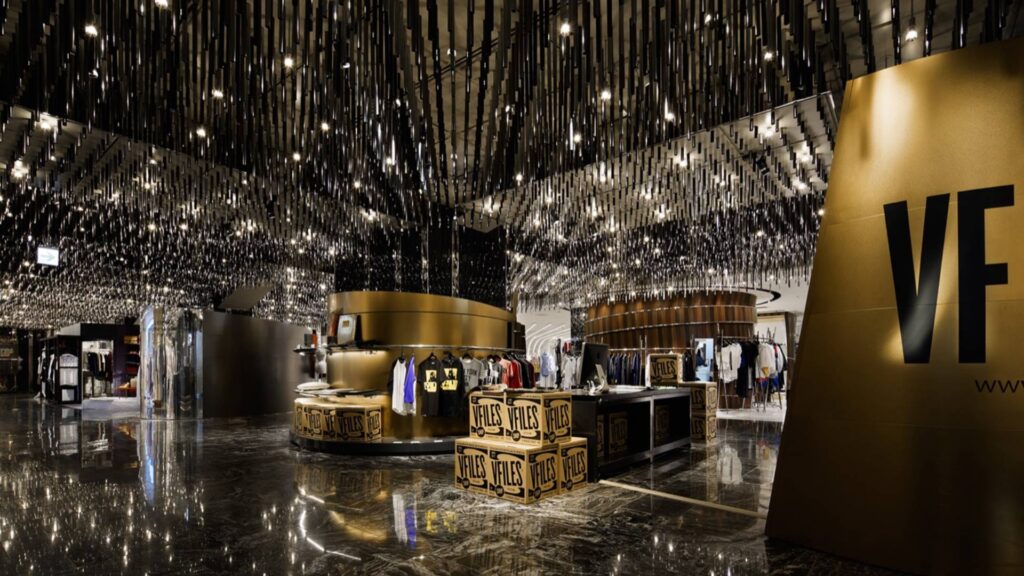
What originally started as a Kimono shop in the late 1800s is now a large department store for high fashion shopping in Shinjuku. The main building is focused on women’s clothing and spans nine floors, including two basement levels. The building adjacent is for men’s clothing and is also nine floors, including one basement. There are three connecting paths between the two buildings on the first basement level, the third floor, and the sixth floor.
Most of the shops and brands you’ll find inside are luxury brands like Dior, Gucci, and Armani, as well as some Japanese designers. However, you will find some different and unique items throughout the mall. There are also multiple restaurants with different cuisines to try out after all that shopping.
Address: 3 Chome-14-1 Shinjuku, Shinjuku City, Tokyo 160-0022 Hours: Saturday-Thursday 10:00 AM- 8:00 PM, Closed Friday
Yodobashi Camera
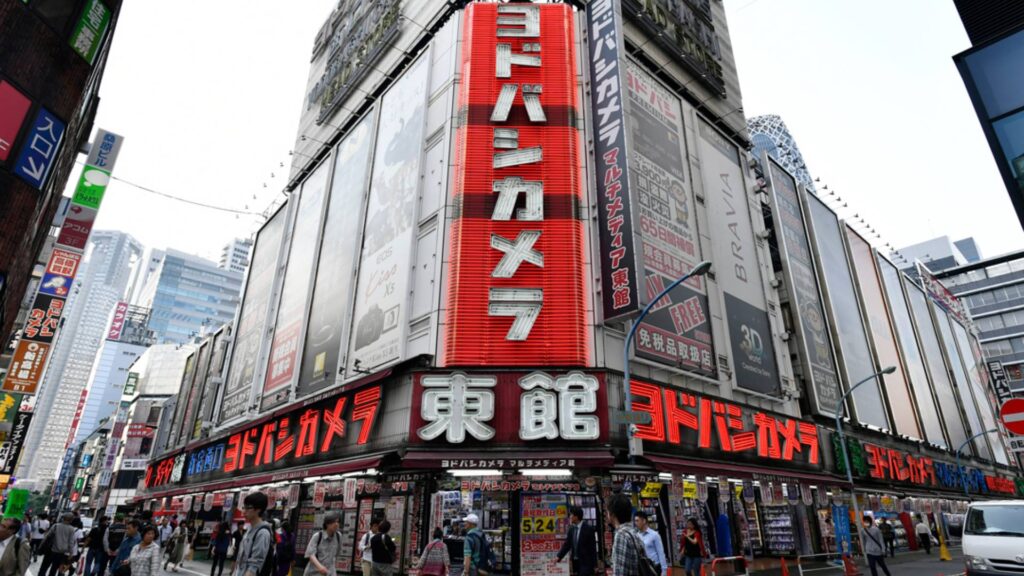
One of the largest electronics shops and a huge chain store is Yodobashi Camera in Shinjuku, but they sell a lot more than just cameras. There is a main pavilion that sells multimedia products and then different wings surrounding the main pavilion. The north wing is nine floors tall, selling laptops, phones, TVs, audio players, kitchen supplies, sewing machines, and printing supplies. The west wing even sells otaku goods like figurines and Nintendo games.
Selling such a vast array of electronics and more, Yodobashi Camera is a great spot for people who like electronics and games.
Address: 1 Chome-12-3 Nishishinjuku, Shinjuku City, Tokyo 160-0023 Hours: 9:30 AM- 10:00 PM
Ninja Trick House

Shinjuku is full of fun and unique activities since it is so focused on entertainment, and the Ninja Trick House is just one example. Here you can see what it’s like to be a real-life ninja, with shuriken and kunai throwing, sword training and fighting, and watching videos and learning about what it means to be a ninja. You dress up in the full ninja outfit, get a little photoshoot and learn all the ropes of being a ninja.
This is a fun and educational experience, something to show your friends and family once you’ve finished and become a full-fledged ninja. Once you enter through the torii gates, you have left the city of Shinjuku and entered a whole different world on the path to being a ninja.
Address: 〒160-0021 Tokyo, Shinjuku City, Kabukicho, 2 Chome−28−13 第一和幸ビル 4階 Hours: Thursday-Monday 10:00 AM- 6:00 PM, Closed Tuesday-Wednesday
Recommended Accommodations in Shinjuku Ward
Mimaru Tokyo Shinjuku West (4 Stars)
MIMARU TOKYO SHINJUKU WEST is located in Tokyo, 300 metres from Bunka Gakuen Costume Museum and 500 metres from Zenrosai Hall Space Zero. Popular points of interest nearby include the Intercommunication Centre, Yamano Hall, and Kumano Shrine. Additionally, nearby attractions include the Tokyo Metropolitan Government Building, Bellesalle Nishi Shinjuku, and the Memorial Museum for Soldiers, Detainees in Siberia, and Postwar Repatriates.
Shinjuku Prince Hotel (4 Stars)
Right next to the lively Kabukicho area, Shinjuku Prince Hotel is a 5-minute walk from JR Shinjuku Station. It features massage services and a Japanese restaurant with panoramic city views. The hotel is a 10-minute walk from Isetan Department Store and a 10-minute drive from Shinjuku Gyoen Garden. Nearby Shinjuku Station offers direct train access to the Shibuya and Harajuku areas within 5 minutes. The hotel is directly above Seibu-Shinjuku Train Station.
RoNa Hotel (3 Stars)
Located in Tokyo, within 200 metres of Okubo Baptist Church and 300 metres of Shinjuku Eastside Square, RoNa Hotel provides free WiFi throughout the property. The hotel is close to Full Gospel Tokyo Church, Inari Kio Shrine, and Statistical Museum. Popular points of interest near RoNa Hotel include Itsukushima Shrine Nukebenten, Hozen-ji Temple, and Saikoan Shrine. The nearest airport is Tokyo Haneda International Airport, 17 km from the hotel.
THE KNOT TOKYO Shinjuku (3 Stars)
Open since August 2018, Hotel The Knot Tokyo Shinjuku provides accommodation in Tokyo, 1.8 km from Meiji Jingu Shrine. Guests can enjoy city views. Shinjuku Gyoen National Garden is 2 km from Hotel The Knot Tokyo Shinjuku, while NHK Studio Park is 2.7 km away. The nearest airport is Tokyo Haneda International Airport, 17 km from the property.
Hotel Cen (3 Stars)
The property is close to popular attractions like Choko-ji Temple, Korea Museum, and Inari Kio Shrine. Popular points of interest near the hotel include Meotogi Shrine, Koizumi Yakumo Memorial Park, and Yodobashi Church. The nearest airport is Tokyo Haneda International Airport, 30 km from HOTEL CEN.
Toyoko Inn Tokyo Shinjuku Kabukicho (3 Stars)
Ideally located in the Shinjuku Ward district of Tokyo, Toyoko Inn Tokyo Shinjuku Kabukicho is 90 metres from Inari Kio Shrine, 100 metres from Korea Museum, and 200 metres from Samurai Museum. The property is around 300 metres from Choko-ji Temple, 400 metres from Godzilla Head, and 400 metres from Zenryu-ji Temple. The accommodation offers a 24-hour front desk and free WiFi. Popular points of interest near Toyoko Inn Tokyo Shinjuku include Koizumi Yakumo Memorial Park, Okubo Park, and Full Gospel Tokyo Church. The nearest airport is Tokyo Haneda International Airport, 17 km from the accommodation.
Shinjuku Partenza (2 Stars)
Shinjuku Partenza is located in the Shinjuku Ward district of Tokyo, 500 metres from Koun-ji Temple and 500 metres from the Grave of Mokuami Kawatake. Popular points of interest near the apartment include Shokenji Temple, Kyomyoji Temple, and Gentsuji Temple. The nearest airport is Tokyo Haneda International Airport, 33 km from Shinjuku Partenza.
UNPLAN Kagurazaka (2 Stars)
Set in the Shinjuku Ward district in Tokyo, 1.6 km from Yasukuni Shrine, Unplan Kagurazaka features air-conditioned rooms with free WiFi throughout the property. Guests can enjoy the on-site bar and cafe, where coffee and lunch are served. Chidorigafuchi is 2.3 km from UNPLAN KAGURAZAKA, while Shinjuku Gyoen National Garden is 2.9 km from the property.
Shinjuku Kuyakusho-mae Capsule Hotel (1 Star)
Located in the heart of the lively Shinjuku area, the Kuyakusho-mae Capsule Hotel is 350 metres from Shinjuku Train Station. It offers compact capsule beds with a private TV and an alarm clock. The unique capsule rooms at Shinjuku Kuyakusho-mae Capsule Hotel are placed side-by-side in a large common area.
Bathrooms and toilets are shared, and amenities are provided. Right across the street from the Shinjuku Ward Office, the hotel is a 5-minute walk from Isetan Department Store, the lively Kabukicho area, and Shinjuku San-chome Subway Station. Shinjuku Gyoen National Garden is a 10-minute walk.
Keio Plaza Hotel Tokyo (5 Stars)
Located in Shinjuku’s Skyscraper District just a 5-minute walk from Shinjuku Train Station, Keio Plaza Hotel Tokyo offers sweeping views of Shinjuku. The Tokyo Metropolitan Government Building is less than a 5-minute walk away, and the Kabukicho area is a 15-minute walk. Meiji Jingu Shrine and Shinjuku Gyoen National Garden are both about a 20-minute walk away.
Discover the Charm of Shinjuku Ward
What do you think about Shinjuku Ward in Tokyo? Do you enjoy learning about the history and culture of this fascinating area? With so much history and so many unique activities in this local neighbourhood of Tokyo, there’s always something new to explore. If you’re interested in visiting, make sure to refer back to this blog for more insights and recommendations.


Trackbacks/Pingbacks